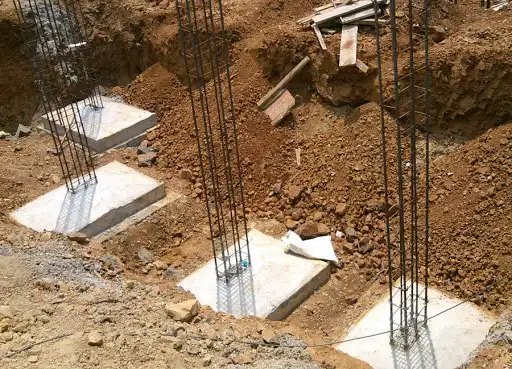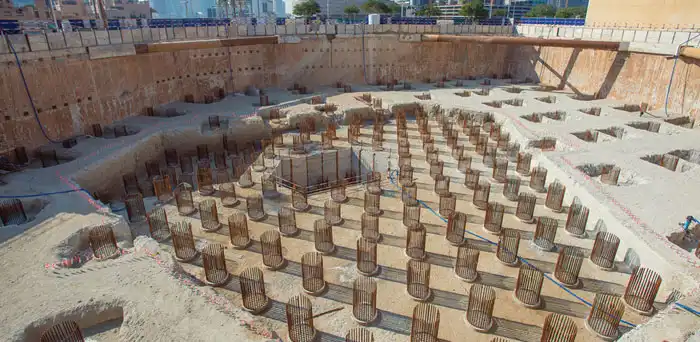In engineering, a foundation is the element of a structure which connects it to the ground, and transfers loads from the structure to the ground. Foundations are generally considered either shallow or deep. Foundation engineering is the application of soil mechanics and rock mechanics in the design of foundation elements of structures.
Requirements of a good foundation
- The design and the construction of a well-performing foundation must possess some basic requirements that must not be ignored. They are:
- The design and the construction of the foundation is done such that it can sustain as well as transmit the dead and the imposed loads to the soil. This transfer has to be carried out without resulting in any form of settlement that can result in any form of stability issues for the structure.
- Differential settlements can be avoided by having a rigid base for the foundation. These issues are more pronounced in areas where the superimposed loads are not uniform in nature.
- Based on the soil and area it is recommended to have a deeper foundation so that it can guard any form of damage or distress. These are mainly caused due to the problem of shrinkage and swelling because of temperature changes.
- The location of the foundation chosen must be an area that is not affected or influenced by future works or factors
Different Types of foundation
There are four types of foundation, namely Shallow foundations, Deep foundations Monopile foundations and Individual footings,
Shallow foundations
Shallow foundations are those found near to the finished ground surface; generally where the founding depth (Df) is less than the width of the footing and less than 3m. These are not strict rules, but merely guidelines: basically, if surface loading or other surface conditions will affect the bearing capacity of a foundation it is ‘shallow’. Shallow foundations (sometimes called ‘spread footings’) include pads (‘isolated footings’), strip footings and rafts.
Shallows foundations are used when surface soils are sufficiently strong and stiff to support the imposed loads; they are generally unsuitable in weak or highly compressible soils, such as poorly-compacted fill, peat, recent lacustrine and alluvial deposits, etc.
There are three types of shallow foundation- Pad foundations, Strip foundations and Raft foundations.

Pad foundations
Pad foundations are used to support an individual point load such as that due to a structural column. They may be circular, square or rectangular. They usually consist of a block or slab of uniform thickness, but they may be stepped or haunched if they are required to spread the load from a heavy column. Pad foundations are usually shallow, but deep pad foundations can also be used.
Strip foundations
Strip foundations are used to support a line of loads, either due to a load-bearing wall or if a line of columns need supporting where column positions are so close that individual pad foundations would be inappropriate.
Raft foundations
Raft foundations are used to spread the load from a structure over a large area, normally the entire area of the structure. They are used when column loads or other structural loads are close together and individual pad foundations would interact.
A raft foundation normally consists of a concrete slab that extends over the entire loaded area. It may be stiffened by ribs or beams incorporated into the foundation.
Raft foundations have the advantage of reducing differential settlements as the concrete slab resists differential movements between loading positions. They are often needed on soft or loose soils with low bearing capacity as they can spread the loads over a larger area.
Deep foundations
Deep foundations are those found too deeply below the finished ground surface for their base bearing capacity to be affected by surface conditions, this is usually at depths >3 m below finished ground level. They include piles, piers and caissons or compensated foundations using deep basements and also deep pad or strip foundations. Deep foundations can be used to transfer the loading to a deeper, more competent strata at depth if unsuitable soils are present near the surface.

Piles
They are relatively long, slender members that transmit foundation loads through soil strata of low bearing capacity to deeper soil or rock strata having a high bearing capacity. They are used when for economic, constructional or soil condition considerations it is desirable to transmit loads to strata beyond the practical reach of shallow foundations. In addition to supporting structures, piles are also used to anchor structures against uplift forces and to assist structures in resisting lateral and overturning forces.
Piers
These are foundations for carrying a heavy structural load that is constructed insitu in a deep excavation.
Caissons
They are a form of deep foundation which are constructed above ground level, then sunk to the required level by excavating or dredging material from within the caisson.
Compensated foundations
These are deep foundations in which the relief of stress due to excavation is approximately balanced by the applied stress due to the foundation. The net stress applied is therefore very small. A compensated foundation normally comprises a deep basement.
Monopile foundation
A monopile foundation utilizes a single, generally large-diameter, foundation structural element to support all the loads (weight, wind, etc.) of a large above-surface structure. A large number of monopile foundations have been utilized in recent years for economically constructing fixed-bottom offshore wind farms in shallow-water subsea locations.
The typical construction process for a wind turbine subsea monopile foundation in sand includes driving a large hollow steel pile, of some 4 m in diameter with approximately 50mm thick walls, some 25 m deep into the seabed, through a 0.5 m layer of larger stone and gravel to minimize erosion around the pile. A transition piece (complete with pre-installed features such as boat-landing arrangement, cathodic protection, cable ducts for submarine cables, turbine tower flange, etc.) is attached to the driven pile, and the sand and water are removed from the centre of the pile and replaced with concrete. An additional layer of an even larger stone, up to 0.5 m diameters, is applied to the surface of the seabed for longer-term erosion protection.

Individual Footing
When the footing supports a separate column, it is referred to as individual footing. It is sometimes denoted as spread footing or isolated footing. For the purpose of analysis, footing may be considered as a simple flat plate or slab. It can be square in plan, acted upon by the concentrated load and distributing the load onto soil. Usually the footing is in the shape of square, rectangular and circular.
The enlarged size of the footing at the bottom gives an augmented contact surface area between soil and footing. This area serves and decreases stress on soil to an allowable amount. It will prevent the excessive bearing failure or settlement. Generally types of individual footing are simple footing, sloped footing and stepped footing. It is economical, when compared with other types of footing. It is provided in cases, where the bearing capacity of the soil is good at shallower depths. It is easy to construct.Generally foundation is designed to satisfy the basic three criteria as follows, 1) the foundation must be aligned correctly in both the vertical and horizontal direction, 2) should be safe from bearing capacity failure and 3) safe from extreme settlement. Loads on the foundation are self-weight loads, live loads, earthquake loads, earth pressure, and water pressure.

Factors affecting the depth of a foundation
- Thickness of top layer
- Ground freezing
- Depth of volume change
- Depth of scour
- Groundwater Level
- Underground utilities and defects
- Property line and adjoining structures
- Sloping ground
- Foundations at different level
Design for foundation engineering
The design of the foundation depends on soil consolidation and bearing capacity.
Soil consolidation refers to the mechanical process by which soil changes volume gradually in response to a change in pressure. This happens because soil is a two-phase material, comprising soil grains and pore fluid, usually groundwater. When soil saturated with water is subjected to an increase in pressure, the high volumetric stiffness of water compared to the soil matrix means that the water initially absorbs all the change in pressure without changing volume, creating excess pore water pressure. As water diffuses away from regions of high pressure due to seepage, the soil matrix gradually takes up the pressure change and shrinks in volume. The theoretical framework of consolidation is therefore closely related to the diffusion equation, the concept of effective stress, and hydraulic conductivity.
In the narrow sense, “consolidation” refers strictly to this delayed volumetric response to pressure change due to gradual movement of water. Some publications also use “consolidation” in the broad sense, to refer to any process by which soil changes volume due to a change in applied pressure. This broader definition encompasses the overall concept of soil compaction, subsidence, and heave. Some types of soil, mainly those rich in organic matter, show significant creep, whereby the soil changes volume slowly at constant effective stress over a longer time-scale than consolidation due to the diffusion of water. To distinguish between the two mechanisms, “primary consolidation” refers to consolidation due to dissipation of excess water pressure, while “secondary consolidation” refers to the creep process.

Geotechnical engineers use oedometers to quantify the effects of consolidation. In an oedometer test, a series of known pressures are applied to a thin disc of soil sample, and the change of sample thickness with time is recorded. This allows the consolidation characteristics of the soil to be quantified in terms of the coefficient of consolidation and hydraulic conductivity.
The bearing capacity is the capacity of soil to support the loads applied to the ground. The bearing capacity of soil is the maximum average contact pressure between the foundation and the soil which should not produce shear failure in the soil. Ultimate bearing capacity is the theoretical maximum pressure which can be supported without failure; allowable bearing capacity is the ultimate bearing capacity divided by a factor of safety. Sometimes, on soft soil sites, large settlements may occur under loaded foundations without actual shear failure occurring; in such cases, the allowable bearing capacity is based on the maximum allowable settlement. There are three modes of failure that limit bearing capacity: general shear failure, local shear failure, and punching shear failure. It depends upon the shear strength of soil as well as shape, size, depth and type of foundation.
A general bearing failure occurs when the load on the footing causes large movement of the soil on a shear failure surface which extends away from the footing and up to the soil surface. Calculation of the capacity of the footing in general bearing is based on the size of the footing and the soil properties. The basic method was developed by Terzaghi, with modifications and additional factors by Meyerhof and Vesić. The general shear failure case is the one normally analyzed. Prevention against other failure modes is accounted for implicitly in settlement calculations
Conclusion
A building foundation actually performs a number of functions. The three most important are to bear the load of the building, anchor it against natural forces such as earthquakes, and to isolate it from ground moisture. The relative importance of these functions changes with the type of land underneath the building and the building design. For smaller accessory buildings such as sheds, a foundation is less important
Info source – environment.uwe.ac.uk, yourarticlelibrary.com, nptel.acin, issmge, hunker, padeepz.net, en.wikipedia.org, jfbrennan.com, offshorewind.biz, nsccme.com, understandconstruction.com,


Comments are closed.